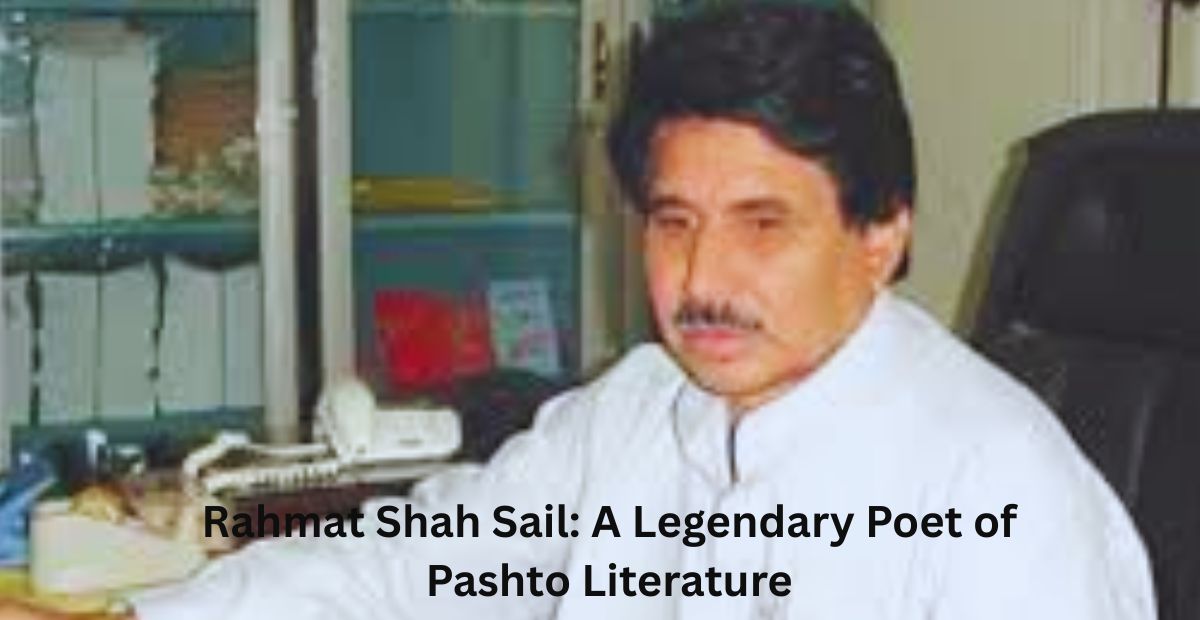Pashto literature boasts a rich tradition of poetic expression, with countless poets contributing to its depth and beauty. Among these stalwarts is Rahmat Shah Sail, a poet whose works have left an indelible mark on the Pashto language and literary landscape. Born in 1950, Sail hails from the Utmankhel tribe, a group renowned for its rich cultural history. His early life, marked by hardship and resilience, mirrors the essence of his poetry, which often reflects themes of love, sorrow, and the struggles of life.
Early Life and Struggles
Rahmat Shah Sail was born in the Dargai village of Wartier, located in the Malakand Agency of Pakistan. He grew up in a modest family environment, with his father Amin Gul and mother Khana Bibi. Due to financial difficulties, Sail’s formal education was cut short. At just five years old, he enrolled in a local primary school, but by the third grade, he had to leave his studies and assist his family in earning a livelihood. Despite this early setback in education, Sail’s love for literature and poetry never waned. His life experiences would go on to shape the powerful verses he would later pen.
Literary Journey and Notable Works
Rahmat Shah Sail’s literary career began as a natural outgrowth of his deep emotions and observations about life and society. His poetry, deeply rooted in Pashto traditions, speaks to the heart of the Pashtun culture while addressing universal themes of love, loss, and the human condition. Through his words, Sail not only gave voice to the everyday struggles of ordinary people but also captured the essence of Pashto identity and pride.
Some of his most celebrated works include:
- “Da Weer Pa Chum Ka War Da Naghmu” (د وير په چم کې وار د نغمو دی): This poem delves into the theme of sorrow and the longing for lost times.
- “Da Lumbu Pa Soori” (د لمبو په سيوري): A piece that paints vivid imagery of nature and its connection to human emotions.
- “Da Khaistoonu Da Sparly Badoona” (د ښايستونو د سپرلي بادونه): A celebration of beauty and the fleeting nature of time.
- “Dard Che De Sareeko Sangay Wosparalay” (درد چې د څړيکو څانګې وسپړلې): A poignant reflection on pain and suffering.
- “De Weeno Rang Pa Lambo Sanga Khkarey” (د وينو رنګ په لمبو څنګه ښکاري؟): A powerful commentary on the struggles of life, depicting blood and flames as metaphors for sacrifice and suffering.
- “Ta La Tasweer Pa Gulaab Joor Kram Ka Na” (تاله تصوير په ګلاب جوړ کړم که نه): A delicate meditation on love, art, and creation.
In addition to these, his “Akhrey Sandara” (آخري سندره), “Ya Zra Gure Dalta Ba Gul Na Spare” (يه زړۀ ګورے دلته به گل نۀ سپړې), and “Nargis Bimar Bimar” (نرګس بیمار بیمار) are among his most revered works, where he explores deep emotions such as pain, hope, and the human spirit’s resilience.
Cultural and Social Influence
Rahmat Shah Sail’s poetry is not just about personal feelings but reflects the larger societal and cultural landscapes of Pashtuns. He writes with a deep sense of history, often invoking figures like Bacha Khan, the iconic Pashtun leader, whose thoughts and philosophies influenced much of Sail’s work. Sail’s “Da Bacha Khan Da Afkaro Manawi Taswerona” (د باچاخان د افکارو معنوی تصویرونہ) is a notable example of this, where he pays tribute to the great leader’s ideologies.
Sail’s influence extends beyond the written word. His works have inspired countless other poets and writers in the Pashto literary world. He is regarded as a beacon of Pashto poetry, with his poems recited in homes, gatherings, and public forums.
A Life Shaped by Passion and Perseverance
Despite the lack of formal education, Rahmat Shah Sail’s passion for Pashto poetry never faltered. His life has been a testament to the idea that creativity and literary talent are not confined to traditional educational paths. His struggles, both personal and societal, are woven into the very fabric of his poems, offering readers a window into the emotional depth and complexities of the Pashtun experience.
Sail’s works are filled with vivid imagery, emotional depth, and a rich connection to the land and people of Pashtunistan. His words speak not just to the hearts of Pashtuns but resonate with anyone who has ever experienced love, pain, and the struggle for meaning in life.
Legacy and Recognition
Rahmat Shah Sail’s contribution to Pashto literature has been widely recognized. His works have received accolades from critics and enthusiasts alike, and his name remains a cornerstone of Pashto poetry. His influence continues to grow, with new generations of poets drawing inspiration from his literary style and themes.
In recognition of his significant contributions, several institutions and literary circles have celebrated his work, ensuring that his legacy continues to thrive. Sail’s poetic journey, despite its humble beginnings, has become an inspiration for both aspiring and established poets within Pashto literary circles.
Conclusion
Rahmat Shah Sail’s legacy as a Pashto poet is one of passion, perseverance, and profound connection to his roots. His poetry, steeped in the culture and struggles of the Pashtun people, continues to resonate with readers and listeners alike. Through his words, Sail has ensured that the rich tradition of Pashto literature remains alive and thriving for future generations.
His journey from the humble fields of Dargai to the heights of Pashto literary excellence is a reminder that the greatest works often come from the most unexpected places. For anyone interested in Pashto literature, Rahmat Shah Sail’s poetry is a treasure trove of insight, emotion, and cultural pride.
